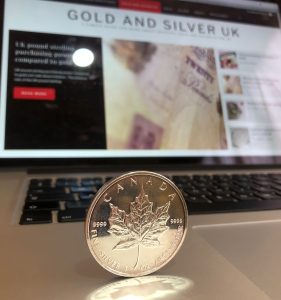Table of Contents
What is gold and silver bullion?

Bullion, 24-carat, 999 fine, 9999 fine, 99.5% pure. What does it all mean?
If you are new to investing in gold and silver, then you will often come across the term ‘bullion’, 24-carat (spelt karat in U.S.), 9999 fine, 99.5% pure etc.
What is bullion?
A classic term for bullion is basically gold and silver (and other precious metals) in the form of bullion bars, ingots and bullion coins.
Gold bullion is usually used for investment purposes, and is based on its purity level such as 24-carat gold, .9999 fine or 99.99% pure gold.
100% pure gold bullion is basically impossible to refine, so bullion gold and silver refiners use 99.99% pure gold bullion for general production. For example, the gold Canadian maple leaf coin or gold British Britannia coins are .9999 fine gold, however, anything over .995 fine (99.5% pure gold) is considered good for investment purposes.
Modern silver bullion coins and bars usually have purity of 99.9% (.999 fine).
What is .999 or .9999 fine gold or silver?
It refers to purity in parts per 1000, so 999 parts are gold/silver. 999.9 parts offers additional purity, however, in reality .999 is widely considered pure. ‘Millesimal fineness’ is a particularly common practice when it comes to the purity of fine gold, a percentage, or per decimal. For example, fine gold with a 999.9 millesimal fineness could also be described as 99.99% pure, or .9999 fine.
What is pure gold or silver?
Pure gold bullion and silver bullion is basically describing the same thing in percentage terms.
.999 fine would be 99.9% pure gold or silver and .9999 fine would be 99.99% pure gold or silver.
What about 24-carat? (karat in U.S.).
Carat (not to be confused with the unit used to measure the weight of precious gems such as diamonds) is basically the proportion of gold in a coin, bar, jewellery etc., to other base metals worked out in 24 parts. Using the carat system, 24-carat would be considered pure gold and, therefore, 14-carat would be 14 parts gold to 10 parts other metals.
14-carat, for example, would be 58% gold or 585 fineness.
According to the LBMA (London Bullion Market Association), the minimum purity for investment gold bars is .995 fineness and .999 fineness for silver bars.
For example, ingots are a specific type of gold bar which uses a specific mould process which also has to abide by a set of rules issued by the LBMA. Also known as the Good Delivery Rules.
The LBMA stands for the London Bullion Market Association, who essentially set the standard for the global wholesale market of bullion grade gold and silver.
The LBMA’s job is to ensure the integrity and quality of certified bullion gold and silver, as well as approve, review and audit companies within the precious metals market.
Gold and silver bullion bars that are “LBMA Certified”, means they can only be specifically made by LBMA approved refineries that meet a specific high standard set by the LBMA. This is also known as the Good Delivery List.
The Good Delivery List is an internationally recognised standard for physical gold and silver bullion, which includes what is acceptable regarding appearance, shape, purity and more.
Bullion, therefore, is different than other gold or silver products that you often see in gold or silver jewellery or numismatic coins. Bullion is purely for investment purposes and is mainly based on the spot price of gold or silver, rather than the artistry of jewellery, or the rarity of a numismatic coin.
BullionVault lets private investors around the world access the professional bullion markets. You can benefit from the lowest costs for buying, selling and storing gold and silver.
4 Grams of FREE Silver on Sign up! VISIT BullionVault

